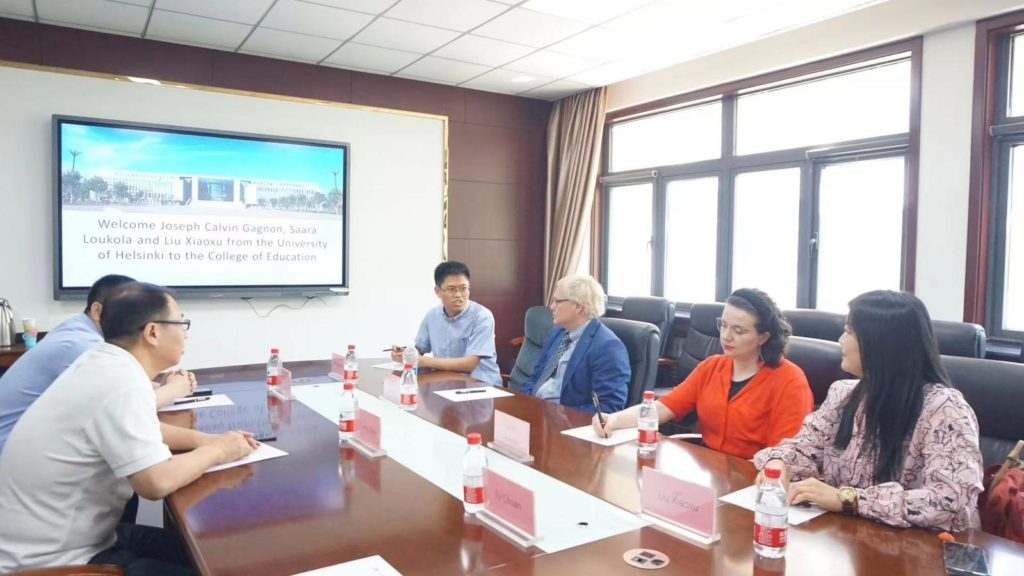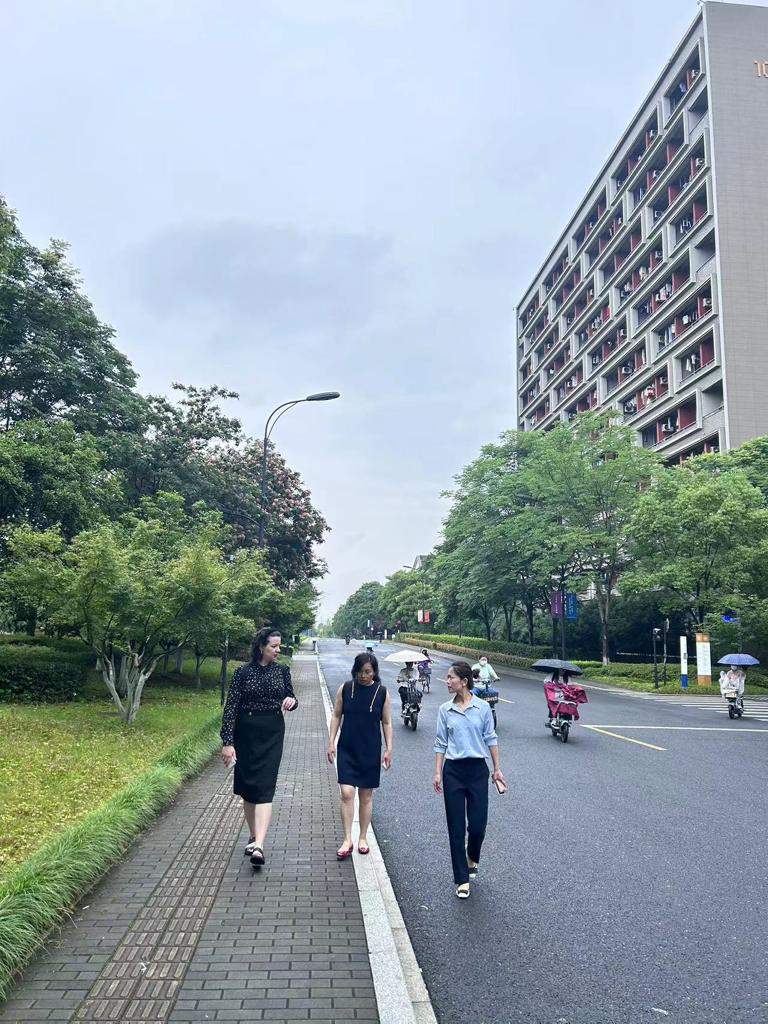
Thanks to a travel grant from the University of Helsinki, I was able to travel to China for two weeks in June 2023. I partook in two workshops at Hangzhou Normal University and Hebei Normal University which were collectively titled organised through the GINTL University of Helsinki seed-funded project “Teacher education for equality and equity in the post-pandemic era: Examples from China and Finland”. In addition, I visited a high school in Shijiazhuang and a daycare in Beijing. I am very thankful for the generosity and kindness of my amazing hosts during all these visits. For purposes of lucidity, I want to note that due to my being a white female teacher and academic from Europe and as a first-time visitor to China without skills in Mandarin or Cantonese, my experience is personal and perhaps limited in that sense.
My trip to China

The main event for my travel, the “Teacher education for equality and equity in the post-pandemic era: Examples from China and Finland” consisted of two different workshops: one at Hangzhou Normal University in Hangzhou, and one at Hebei Normal University at Shijiazhuang. Both workshops were arranged by Xiaoxu Liu, who successfully organised very interesting and interactive sessions and was simultaneously able to function in the role of an organiser, a host, and a translator. In both workshops, we had approximately 20-30 participants who presented and discussed varying topics connected to teacher training and teaching with us. The participants’ academic status varied from bachelor- and master-level students to doctoral and postdoctoral researchers and professors. Both universities are ‘normal universities’, at which the emphasis lies not only on the students but also on the teachers-in-training, who should aim to be excellent role models in their future careers.
Photo (left): Visiting a local high school in Shijiazhuang (photo: Saara Loukola)
It was interesting to note that the demographics of the teacher students are quite like those in Finland – especially the fact that the teacher students are largely young women. Another similarity to Finnish teacher training was how the teacher students were criticising their courses and their arrangements, feeling that the courses were too theoretical and did not prepare them for real classroom events.
Despite these similarities, the university structures in China do differ from Finnish universities. Students pay pay tuition fees for their university attendance, and they live on campus. It was especially interesting to learn that universities also offer accommodation on campus for early-career academics, such as lecturers.

The high school visited in Shijiazhuang has an international emphasis with a student exchange program with a Canadian high school. Even though the school is public, there are tuition fees there – a big difference from the Finnish system, where tuition is free for EU citizens. On top of that, the classes with an international emphasis were remarkably more expensive than other, ‘regular’ classes, and the class sizes were smaller. During our visit, we had a chance to meet four teacher-training students who were conducting their internships in this high school and hear about their experiences. Many of their experiences resembled the experiences of teacher students in Finland; they were struggling to gain authority with their students, wondering what kind of teacher identity they wish to construct. One of them specifically reflected on the big and positive difference it made to student behaviour when misbehaviour was treated with empathy instead of discipline.

The early childhood education center – also called the ‘Discover & Inspire Daycare Center’ – that I visited in Beijing was organised privately with an emphasis on the Finnish curriculum. In practice, this means following and organising learning by the Finnish curriculum for early childhood education, by means of activities such as the systematically basing of children’s learning on their interests, the forming of a child development plan together with parents, and the aiming for long-term planning. The special features of this daycare were the fact that Finnish teachers worked alongside their Chinese colleagues as well as the possibilities for children to learn English. The center also had some additional, quite special, facilities, such as a swimming pool for kids during the summer and a snowboard hill with artificial snow during the winter. Since the daycare had notable attendance fees, similar to those asked for international classes in high school, it can be assumed that most students granted international opportunities from early childhood to high school have a middle-or upper-class background.
Photo (left): The Finnish flavouring of the daycare in Beijing (photo: Saara Loukola)
Equality and education in teacher training: What is discussed in the context of China?
In the first workshop of the “Teacher education for equality and equity in the post-pandemic era: Examples from China and Finland” series, Heidi Layne introduced the following questions in her speech: What do we mean when we talk about social justice in teacher education, and from whose perspective is it approached? These are interesting questions, especially considering that Hebei Normal University and Hangzhou Normal University are located nearly 1,200 kilometres away from each other and function in drastically different areas. Based on these facts and questions, two main themes were discussed in the workshops: micromanagement in the classroom, and rural-urban segregation.
Micromanagement in classrooms, special education, and questions of class
The first main theme was micromanagement in the classroom, concerning, for example, seating order in the classroom, selection of “leader students” in classrooms (who seem to have a remarkable amount of power among their peers), and “star classes”, where academic top students are all placed in the same class. As one teacher trainer described during her internship in a local high school: learning strategies in student groups are diverse, so there exists the challenge of finding diverse teaching strategies to match them.
Similar conversations have also been ongoing in Finland. As it seems from the examples of “star classes”, arrangements can be made within teaching to support students to excel even more; however, support provided for students with learning challenges seemed mostly to be dependent on the teacher’s ability and willingness to do so, as well as on the parents’ ability to use the money on private institutions outside of school. This includes, for example, private doctor visits. From the school’s side, the concrete acts for support remained unclear.
Photo (right): Campus library at Hebei University in Shijiazhuang (photo: Saara Loukola)

From the workshop participants’ descriptions, it seems that the resources available in public and private schools vary a lot. Nevertheless, the high school I visited during my trip has a remarkable amount of psychologists in their teaching staff (23 psychologists out of 200 staff members!), but their role remained a bit unclear to me since they were not helping students with learning challenges or peer relations. Interestingly, the teacher students at the universities criticised one course focusing on mental health that is part of their studies. I couldn’t help but wonder if the aim of these actions seems to be to promote self-optimising citizens rather than to support students with learning challenges.
Rural-urban segregation (and what it actually concerns)
The second theme of conversations was the segregation of education in rural and urban areas. It seems that the resources are drastically different between urban and rural areas. On top of that, rural schools seem to be less attractive to teachers. To balance this difference, there are systems in place such as that of “teacher rotation”, where a teacher from an urban area is assigned to work in a rural area for 3-5 years. Strictly speaking, this is not obligatory, but denying attending might lead to one not advancing in their career. The minimisation of this imbalance between rural and urban segregation has also been the aim of some acts supported by the state, where rural area students are exempted from paying tuition and accommodation fees of university if they agree to return to the rural area after graduation.

Since the theme came up so systematically, I feel that the discussions of “rural segregation” might also be a euphemism for some other conversations. I was wondering if questions of class and assimilation of ethnic and cultural minorities are also implicitly discussed with “rural segregation.” During one workshop, a critical PhD scholar did present on the topic of developing local internalisation, mentioning the concepts of race and ethnicity and therewith handling the topic in some way. However, a generational gap in this topic was clear; an older academic explicitly mentioned during their presentation about teacher students’ experiences of inequality how “racism, ethnicity, or other western concepts” did not appear in their participant’s responses. The situation of national minorities did not come up during the workshops, and hardly during the whole trip, for that matter.
Critical reflections on differences between Finnish and Chinese teacher training and education structures
Teachers are used to a remarkable amount of autonomy in the Finnish education system, and this autonomy seemed to be of great interest among teacher trainers in China. Many of them had heard about the phenomenon-based learning approach that is widely used in Finland, and especially younger teacher students had a lot of questions about it. This high number of questions may be due to the fact that the national curricula in China must be followed closely in education and teaching. Its results are controlled in everyday education, both in teacher training and in wider structures of education.

One example of this strict monitoring of the curricula is the massive amount of standardized testing that is in place for students. Another example is the merit system that increases some schools’ teachers’ salaries if their students succeed in these tests. Another, the very strict teacher evaluation system. The list goes on: There are classrooms with video cameras, where the videotaped material (and teachers’ actions) from the previous month are watched during inspections. There are surveillance visits to international schools, where all English books are hidden and even the number of wooden building blocks must match the requirements (99 pieces). A strict hierarchy exists in organisations, where international teachers working in China are avoided by their bosses for asking too many “why?”-questions. And then there are the instances of social control, such as one friend or colleague recommending another to avoid wearing a “Commodore 64”-shirt due to its interpreted reference to the date of Tiananmen’s Squares protests.
Photo (left): A local tourist in front of Mao’s picture at Tiananmen Square (photo: Saara Loukola)
There seems to be a strong interest in as well as a large amount programs for developing the quality of education and teacher training in China, though only within a strict frame. I do also acknowledge that our visit might have helped to legitimise the structures of inequality in teacher training. My presupposition before the trip was that even if the theme is equality and equity in teacher training, it would be discussed within strictly designed frames – not only in the sense that I expected only certain topics to be discussed, but also in that I expected specific themes to be left fully undiscussed. I assumed that gender equality might come up frequently, but it was only mentioned briefly in some of the presentations and never as the main theme in any presentation or discussion. Religion, political stances, and LGBTIQA+ minorities were not mentioned even once. Language politics were left out of the presentations, and as mentioned earlier, ethnic minorities remained undiscussed. The only mention of ethnic minorities during my whole journey was a commercial ‘article’ that appeared in the airplane magazine about Uyghurs, a Turkic ethnic group originating from the general region of Central and East Asia against which the Chinese government has committed a series of ongoing human rights abuses, actions condemned by several human rights organisations.

It is crucial here to acknowledge that it is easy for me to fall into Western arrogance since many of the above-mentioned topics are openly discussed in Finland, and thus easily portray Finnish education as ‘already equal’ – with teacher training claiming innocence despite its struggles to acknowledge and challenge other problems, such as racism and discrimination. However, many of the conversations which are more and more common in Finnish education, such as that of critical multiculturality, seem to not even be on the table yet in China. “Seem” is the crucial word here: I heard from many informants during my trip how important it is in China that things look well on the outside, and it is possible that some more critical conversations are only discussed more privately among Chinese people. Nevertheless, many critical thinkers are located outside of China – not only to be able to have critical conversations about China, but also for their own safety.
Photo (left): Touring the campus area of Hangzhou University. The building on the right is a student dormitory where clothes are drying on the balcony. (Photo: Xiaoxu Liu)
One participant in the workshops shared an allegory in which the Chinese education system was portrayed as having earlier swallowed its food in one big gulp but now having changed its approach to ‘chewing before swallowing’. The same attitude applied to me as a teacher from Finland familiarising myself with the local education context and its challenges. One of the main takeaways from this trip was my newfound understanding of the scope at which everything functions in China. China is a massive country and a rising power politically, economically, and culturally, and due to these facts, its power should not be belittled. Neither should the number of critical voices in teacher education, which may in the future expand to address aspects of equality and equity in teacher training in relation to issues that are as of yet still left undiscussed.
Author

Saara Loukola
Doctoral Researcher, University of Helsinki
saara.loukola[at]helsinki.fi
GINTL travel grants at the University of Helsinki
This activity has been funded by a University of Helsinki GINTL travel grant for co-operation in Africa, China and India.
GINTL at the University of Helsinki (UH) offers travel grants to UH academic staff, doctoral, and post-doctoral researchers, as well as students for travels to African countries, China, and India that cannot be funded from other sources. Travel grants can also be used to invite scholars from these regions to the University of Helsinki.
If you are affiliated with another GINTL higher education institution in Finland, please check if local GINTL travel grants are awarded.













